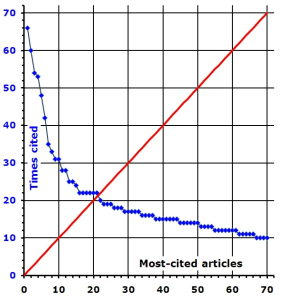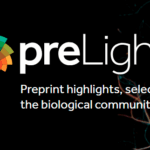
h-index. Source: The University of Auckland.
“Publish or Perish¹” is the maximum that governs academia worldwide for many decades. The term, according to Wikipedia, appeared for the first time in a non-academic context in 1932, in a book authored by H.J. Coolidge, and governs the performance of the academic world, in which there is no place for those who do not frequently publish articles resulting from their research activity.
The strong pressure in academia to publish quickly and continuously to ensure or progress in academic career can produce distortions. Today we are aware of increased amount of irreproducible results, unjustified authorship, plagiarism, self-plagiarism, salami publishing, and other unethical forms of publication, which led to the parallel development of new ways of detecting these unhealthy practices.
In a recent publication in PLoS ONE, researchers led by John Ioannidis, Stanford University, reported a detailed study in Scopus database (of the publisher Elsevier), which identified a fraction of about 150,000 researchers who form the core of the 15 million active researchers worldwide (defined as those who have published at least one indexed article) between 1996 and 2011 This core of researchers, who Ioannidis termed ‘Continuously Publishing Core’ has in particular the fact that they published at least one paper each and every year in the 16 year period analyzed, without failing a single year. This select group of scientists corresponds to only 1% of the total, and has uninterrupted and continuous presence in the literature (UCP).
The authors point out that more important than to publish is to publish constantly and continuously, because only so the effective contribution to science and knowledge would be ensured, although important contributions can be made by isolated publications. The article analyzes the scientific production of researchers who form the core of science in bibliometric aspects, in order to better characterize this population.
The fraction of 150,000 researchers who have continuous presence in the literature – researchers with UCP, and that represent 1% of total active researchers in Scopus, is a very influential core. The h-index² of this population is much higher than those not UCP. At least 75% of those with UCP have h index of 16, while this value is reached only by 0.96% of researchers without UCP, and surprisingly, only 0.76% of those who have failed to publish in any of the years between 1996 and 2011 (called “Skip” authors). A fourth group, called “Skip-1” is formed by researchers who have published continuously in the 16-year period if not for a failure in a single year between 1997 and 2010. Of these, a significant portion, 43.7% has h-index greater than or equal to 16.
Similar differences were observed between groups regarding the total number of publications and total citations received. The proportion of authors with an average of at least 20 citations per article was 38.1% in the UCP group, 10% in those not UCP, 10.3% in Skip and 29.6% in Skip-1. The difference in the number of citations in favor of UCP group is partly due to the fact that these authors publish more articles. However, even counting the average number of citations per article, authors UCP tend to higher citation indexes when the number of papers per author is greater than 50. Below this number of articles/author, the UCP and Skip-1 groups have virtually the same number of citations. The similar behavior of these groups is also observed when the number of publications by author exceeds 350 on the period studied.
The median of the total number of published articles is 94, 1, 1, and 53 for the groups UCP, not UCP, Skip, and Skip-1, respectively; the median total number of citations is 1536, 3, 3, and 712 for UCP, not UCP, Skip and Skip-1, respectively; and finally, the median of the h-index h is equal to 21, 1, 1, and 14 to UCP, not UCP, Skip, and Skip-1, respectively.
The authors, then, performed a sensitivity analysis using a window of two years instead of one year, and the number of researchers who qualified for the UCP group increased three times, jumping to around 46,000 scientists. However, this new group remains qualitatively different from the others, as the UCP group with one-year window.
Scientists that form the UCP group sign about 42% of the 25 million indexed Scopus publications between 1996 and 2011. The presence of UCP scientists is still more striking between highly cited publications, since this group participates as author in 87% of articles that received more than 1000 citations.
The authors analyzed the relative proportion of UCP researchers in different disciplines by taking random samples of 10,000 scientists per group of 13 areas of knowledge. There was a higher presence of UCP authors in the areas of medicine, mathematics/physics, and chemistry, while the presence of non- UCP authors is higher in Social Sciences and Humanities, Engineering, and Computer Science/Electrical Engineering.
Similarly, an analysis of the distribution of authors UCP and not UCP was taken by geographic region. There are predominantly more authors UCP in Europe, and to a lesser extent in North America, while the non-UCP pattern is more prevalent in other regions of the world. As expected, there are more authors UCP in academia and the government sector than in areas such as industry and hospitals. In the distribution analysis, the Skip group resembled the non-UCP group and the Skip-1 group, in large part, has a similar behavior of the UCP group.
The observation that 87% of the most cited scientific literature in Scopus is concentrated on only 1% of all researchers in the database is even more impressive than the observation derivative of the Pareto Principle, which states that eighty percent of the effects come from 20% of causes, and that in scientometry states that 80% of all citations come from 20% of the articles. It has been widely described in the literature that renowned journals concentrate most of the highly cited articles. However, the greatest impact of authors UCP, which have a continuous and uninterrupted flow of publications over 16 years, goes beyond just publishing a greater number of articles. The h-index of authors UCP, which eliminates the bias in its calculation, is significantly higher than in the non-UCP group.
Although undesirable from the point of view of academic career, for many researchers, however, the interruption in publication flow may reflect personal or family situations (the arrival of children, for example) or difficulties in obtaining financing or infrastructure for research. On the other hand, in areas such as humanities and social sciences, where publication of books is the most common form of scientific output, it makes no sense to speak of UCP. The same applies to non-academic institutions such as hospitals or industries, where publishing is not the primary product of the professionals’ work, but can occur concurrently.
The authors draw attention to the fact that the concentration of only 150,000 researchers UCP worldwide is quite rarefied. This number is even smaller if we consider the universe of researchers who have more than one publication per year during the study period. Less than half of this fraction (68,000 scientists) published at least two articles per year in each year; almost 40,000 published at least three articles, one-tenth (15,000) of these published five or more articles and only 3,000 scientists published ten or more articles each and every year between 1996 and 2011 There are many teams, departments or entire institutions without a researcher who integrates the core category. The data show that this number is likely to grow, but still well below the growth pace of the total number of researchers. Furthermore, the low number of authors UCP may reflect inefficiencies of the academic system, personnel management and recruitment policy of young researchers, or yet of research grants. Anyway, in their opinion, it is necessary to keep open the debate, supported by bibliometric indices.
Notes
¹ Publish or perish – http://en.wikipedia.org/wiki/Publish_or_perish#cite_note-5
² HIRSCH, JE. An index to quantify an individual’s scientific research output. PNAS. 2005, vol. 102, nº 46, pp. 16569–16572. Available from: http://www.pnas.org/content/102/46/16569.full
References
Editorial ethics: the detection of plagiarism by automated means. SciELO in Perspective. [viewed 09 August 2014]. Available from: http://blog.scielo.org/en/2014/02/12/editorial-ethics-the-detection-of-plagiarism-by-automated-means/
GARFIELD, E. The significant scientific literature appears in a small core of journals. The Scientist. 1996. Available from: http://www.thescientist.com/?articles.view/articleNo/18038/title/The-Significant-Scientific-Literature-Appears-In-A-Small-Core-Of-Journals/
In the beginning it was just plagiarism – now its computer-generated fake papers as well. SciELO in Perspective. [viewed 09 August 2014]. Available from: http://blog.scielo.org/en/2014/03/31/in-the-beginning-it-was-just-plagiarism-now-its-computer-generated-fake-papers-as-well/
IOANNIDIS, JPA. Concentration of the most-cited papers in the scientific literature: Analysis of journal ecosystems. PLoS One. Available from: http://www.plosone.org/article/info%3Adoi%2F10.1371%2Fjournal.pone.0000005
IOANNIDIS, JPA., BOYACK, KW., and KLAVANS, R. Estimates of the Continuously Publishing Core in the Scientific Workforce. PLoS ONE. 2014, vol. 9, nº 7. Available from: http://www.plosone.org/article/info%3Adoi%2F10.1371%2Fjournal.pone.0101698
Publication ethics and the problem of plagiarism. SciELO in Perspective. [viewed 09 August 2014]. Available from: http://blog.scielo.org/en/2013/10/02/publication-ethics-and-the-problem-of-plagiarism/
Reproducibility of research results: a subjective view. SciELO in Perspective. [viewed 09 August 2014]. Available from: http://blog.scielo.org/en/2014/02/19/reproducibility-of-research-results-a-subjective-view/
 About Lilian Nassi-Calò
About Lilian Nassi-Calò
Lilian Nassi-Calò studied chemistry at Instituto de Química – USP, holds a doctorate in Biochemistry by the same institution and a post-doctorate as an Alexander von Humboldt fellow in Wuerzburg, Germany. After her studies, she was a professor and researcher at IQ-USP. She also worked as an industrial chemist and presently she is Coordinator of Scientific Communication at BIREME/PAHO/WHO and a collaborator of SciELO.
Translated from the original in portuguese by Lilian Nassi-Calò.
Como citar este post [ISO 690/2010]:






![It takes a body to understand the world – why ChatGPT and other language AIs don’t know what they’re saying [Originally published in The Conversation in April/2023] Photograph of a white and silver robot holding a tablet in front of a luggage store. In the background, in the hallway, two people are walking with their backs to the camera.](https://blog.scielo.org/en/wp-content/uploads/sites/2/2023/04/lukas-hND1OG3q67k-unsplash_thumb.jpg)
![Researchers engaging with policy should take into account policymakers’ varied perceptions of evidence [Originally published in the LSE Impact blog in January/2023] Illustration of a board, with wires connecting the elements.](https://blog.scielo.org/en/wp-content/uploads/sites/2/2023/01/Evidence-Perceptions-LSE-Impact_thumb.jpg)









Recent Comments